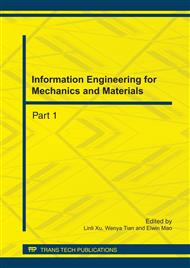[1]
Anthony. Paint pretreatment for aluminum, J. Metal Finishing, 2000, 98(6): 74-79.
Google Scholar
[2]
K.C. Emregül, A.A. Aksüt. The effect of sodium molybdate on the pitting corrosion of aluminum, J. Corrosion Science, 2003, 45(11): 2415-2433.
DOI: 10.1016/s0010-938x(03)00097-0
Google Scholar
[3]
Bommarito GM, Pocius AV. An electrochemical study of the changes in the passivation of an aluminum alloy surface induced by the presence of a self-assembled monolayer, J. Thin Solid Films, 1998, 327-329(31): 481-485.
DOI: 10.1016/s0040-6090(98)00692-0
Google Scholar
[4]
B. Müller. Corrosion inhibition of aluminium and zinc pigments by saccharides, J. Corrosion Science, 2002, 44: 1583-1591.
DOI: 10.1016/s0010-938x(01)00170-6
Google Scholar
[5]
E.E. Foad El-Sherbini, S.M. Abd-El-Wahab, M.A. Deyab. Studies on corrosion inhibition of aluminum in 1. 0 M HCl and 1. 0 M H2SO4 solutions by ethoxylated fatty acids, J. Materials Chemistry and Physics, 2003, 82: 631-637.
DOI: 10.1016/s0254-0584(03)00336-5
Google Scholar
[6]
B. Müller, M. Shahid, G. Kinet. Nitro-and aminopenols as corrosion inhibitors for aluminium and zinc pigments, J. Corrosion Science, 1999, 41: 1323-1331.
DOI: 10.1016/s0010-938x(98)00186-3
Google Scholar
[7]
A. Y. El-Etre. Inhibition of acid corrosion of aluminum using vanillin, J. Corrosion Science, 2001, 43: 1031-1039.
DOI: 10.1016/s0010-938x(00)00127-x
Google Scholar
[8]
B. Müller, A. Paulus, B. Lettmann, et al. Amphiphilic Maleic Acid Copolymers as Corrosion Inhibitors for Aluminum Pigment, J. Journal of Applied Polymer Science, 1998, 69: 2169-2174.
DOI: 10.1002/(sici)1097-4628(19980912)69:11<2169::aid-app8>3.0.co;2-e
Google Scholar
[9]
B. Müller, T. Schmelich. High-Molecular Weight Styrene-Maleic Acid Copolymers as Corrosion Inhibitors for Aluminium Pigments, J. Corrosion Science, 1995, 37: 877-883.
DOI: 10.1016/0010-938x(94)00171-2
Google Scholar
[10]
B. Müller. Citric acid as corrosion inhibitor for aluminium pigment, J. Corrosion Science, 2004, 46: 159-167.
DOI: 10.1016/s0010-938x(03)00191-4
Google Scholar
[11]
Bodo Müller. Polymeric corrosion inhibitors for aluminum pigment, J. Reactive& Functional Polymers, 1999, 39: 165-177.
DOI: 10.1016/s1381-5148(97)00179-x
Google Scholar
[12]
Müller B, Fischer S. Epoxy ester resins as corrosion inhibitors for aluminium and zinc pigments, J. Corrosion Science, 2006, 48(9): 2406-2416.
DOI: 10.1016/j.corsci.2005.10.002
Google Scholar
[13]
Müller B. Paint resins stabilize aluminium pigment, J. European Coatings Journal, 2001(5): 81-92.
Google Scholar
[14]
Glebov E M, Yuan L, Krishtopa L G, et al. Coating of metal powders with polymers in supercritical carbon dioxide, J. Industrial and Engineering Chemistry Research, 2001, 40(19): 4058-4068.
DOI: 10.1021/ie0100939
Google Scholar
[15]
K.H. Zabel, R.E. Boomgaard, G.E. Thompson, et al. Properties of ketimine/acetoacetate coated aluminum substrates, J. Progress in Organic Coatings, 1998, 34: 236-244.
DOI: 10.1016/s0300-9440(98)00016-2
Google Scholar
[16]
Yang X.F., Tallman D.E., Gelling V.J., et al. Use of a sol-gel conversion coating for aluminum corrosion protection, J. Surface and Coatings Technology, 2001, 140(1): 44-50.
DOI: 10.1016/s0257-8972(01)01002-7
Google Scholar
[17]
Shoichiro Yano, Keisuke Iwata, Kimio Kurita. Physical properties and structure of organic–inorganic hybrid materials produced by sol-gel process, J. Materials Science and Engineering C, 1998, 6, 75-90.
DOI: 10.1016/s0928-4931(98)00043-5
Google Scholar
[18]
A. Kiehl, K. Greiwe. Encapsulated aluminium pigments, J. Progress in Organic Coatings, 1999, 37: 179-183.
DOI: 10.1016/s0300-9440(99)00075-2
Google Scholar
[19]
Li L J, Pi P H, Wen X F, et al. Optimization of sol–gel coatings on the surface of aluminum pigments for corrosion protection, J. Corrosion Science, 2008, 50: 795-803.
DOI: 10.1016/j.corsci.2007.11.002
Google Scholar
[20]
Li L J, Pi P H, Wen X F, et al. Aluminum pigments encapsulated by inorganic–organic hybrid coatings and their stability in alkaline aqueous media, J. Journal of Coating Technical Research, 2008, 5 (1) : 77-83.
DOI: 10.1007/s11998-007-9053-9
Google Scholar
[21]
Yasuda H. Plasma Polymerization. New York Academic, (1985).
Google Scholar
[22]
Y. Iriyama, T. Ihara, M. Kiboku. Plasma polymerization of tetraethoxysilane on aluminum granules for corrosion protection, J. Thin Solid Films, 1996, 287: 169-173.
DOI: 10.1016/s0040-6090(96)08780-9
Google Scholar
[23]
Batzilla Th., Tulke A. Preparation of encapsulated aluminum pigments by emulsion polymerization and their characterization, J. Journal of Coatings Technology, 1998, 70: 77-83.
DOI: 10.1007/bf02730153
Google Scholar
[24]
Hui Liu, Hongqi Ye, Yingchao Zhang. Preparation and characterization of PMMA/flaky aluminum composite particle in the presence of MPS, J. Colloids and Surfaces A: Physicochemical and Engineering Aspects, 2008, 315(1-3): 1-6.
DOI: 10.1016/j.colsurfa.2007.06.057
Google Scholar
[25]
Isao Kimura, Yoshinari Taguchi, Haruyuki Yoshii, et al. Encapsulation of aluminum flakes by dispersion polymerization of styrene in a nonaqueous system with reactive surfactants, J. Journal of applied polymer science, 2001, 81: 675-683.
DOI: 10.1002/app.1484
Google Scholar
[26]
Hui Liu, Hongqi Ye and Xinde Tang. Aluminum pigment encapsulated by in situ copolymerization of styrene and maleic acid, J. Applied Surface Science, 2007, 254(2): 616-620.
DOI: 10.1016/j.apsusc.2007.06.047
Google Scholar
[27]
Carpenter. Nitro-substituted polymeric corrosion inhibitors for aluminum flake pigment, U.S. Patent 5389139, 1995-2-14.
Google Scholar
[28]
Nishikawa Shuichi, Kojo Kazuo. Resin-Coated Aluminum Pigment, JP Patent 2005146111A, 2005-6-9.
Google Scholar
[29]
Nishikawa Shuichi. Silica-coated Aluminum Pigment and Its Manufacturing Method, JP Patent 2002088274, 2002-3-27.
Google Scholar
[30]
Russell L. Ferguson. Surface-Treated Aluminum Pigments for Environmental Compliance, http: /www. pcimag. com, (2005).
Google Scholar


